Small or experimental games for VR and Interactive Fiction.
Educational, historical, and explorational.
Where Art Thou?
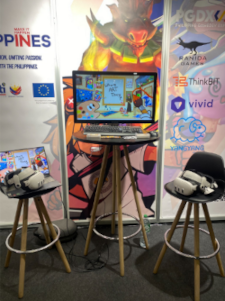
Demo’d at Gamescom 2024
•Magical Museum
•Mythological Subjects
•Dramatic Intrigue!
The museum’s animated mascot starts cleaning the museum up after an “artquake”, but is slowly drawn into a mystery when several paintings disappear. What happened during this artquake? The answer lies in the panels of a triptych torn between reality and fantasy!
Narrative was designed to be especially flexible. Using a very small main critpath, any additional paintings could become (at design's discretion) either part of progression, background scenery, or even completely cut.
Similarly, each Act ended on a dramatic cliffhanger, leaving plenty of room for episodes or updates!
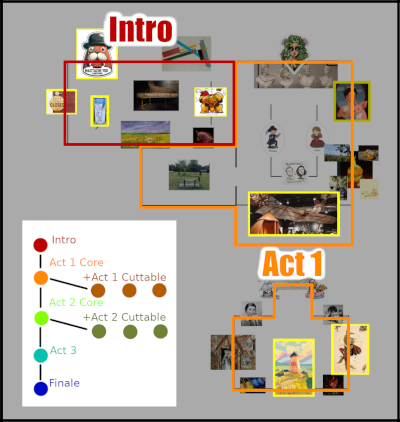
I designed and roughed out infographics for all the controls to quickly, easily, and thoroughly communicate the controls to players. So many things in VR can be finicky, and we wanted to maximize players’ abilities to jump in and just enjoy the fun.
The infographics showed 3 things: an avatar, a button map, and minimal text. The avatar quickly conveyed the control goals, reinforced by minimal text. The controller map focused on the relevant button presses. I chose to include both controllers while emphasizing the correct one to help overcome any hand position dyslexia.
I also designed several ways to communicate puzzles.
1. Hints could be found in the text of the painting plaques, which created a minimal amount of translatable text.
2. “Dialogue” could also be interpreted from emojis that would always face the player. These would typically reinforce or compliment plaques.
3. Finally, players could also get dialogue, including hints, from their companion Palette, but this was intended to be stronger guidance for confused players.
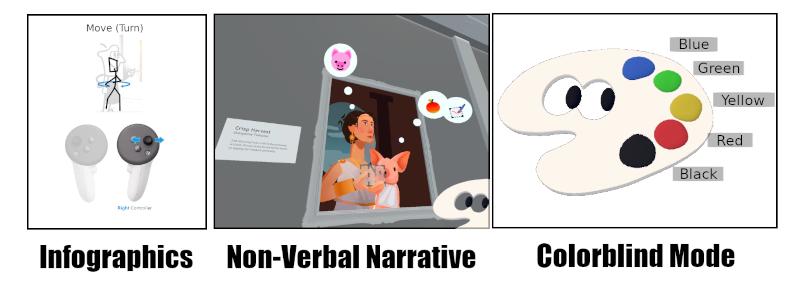
I had several design accessibility concerns: ways to label colors, the ability to switch brush hands between right and left, and the ability to set player height. Planning for these from the start were very important to me.
Divis Mortis
Solve puzzles and fight enemies to survive the zombie apocalypse in this text adventure.
The game that started it all, this is just about the first video game I ever created! I taught myself how to program in Inform 7 using nothing but documentation, determination, and careful planning.
I mostly like Divis Mortis. It is fun, which is partially due to the pleasing sensation that the puzzles are grounded in the physics of the world model, which is something that should always happen in IF but too often doesn't.
-Ben Dixon
The narration here is, on the whole, pretty well done.
-Dora
[T]his being a particularly well written piece of interactive fiction (a text adventure, if you prefer) it actually manages to feel realistic and tense.
-Gnome
[I]t is over all a solid and fun game: fun if you like lite, light-hearted horror with a bit of grisle.
-Conrad
I had to overcome some common first-timer mistakes (who knew making doors could be so complicated?) but I made sure my fun paper designs were supported with good implementation and rigorous testing, from both myself and the community. From the beginning, I have cared about being thorough and diligent.
Divis Mortis ended up getting 11th place out of 26: decidedly not bad for a medium-length text adventure. I'm proud of that placement, for a first attempt in a year with especially strong competition. It was a strong outcome for what was ultimately an expression of my phobia of zombies.
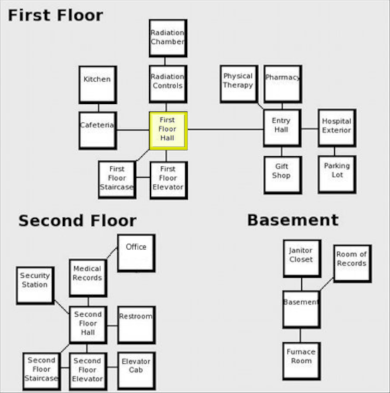
First Floor Hall
You walk into a central hub of nondescript, pristinely sterile hospital hallway. The lights flicker with the dim light of the emergency power generator. The lack of noise sends a chill down your spine. Where there should be doctors rushing, nurses chatting, and patients complaining, you hear absolutely nothing. You wonder if this building has been quarantined off or if the infection has spread beyond it. You are thankful that there are no more signs of trouble: no blood on the walls, no corpses on the ground. Then again, this does make your situation more uncertain.
You can go north to the Radiation Controls, south to the Elevator, east to the Hospital Entry, or west to the Cafeteria.
During the design phase, I learned a lot about pacing, tone, puzzle design, walkthrough/hint design, and mapping, which I then took and applied to my next game, Coloratura. The strongest lesson for me was around scope and planning, and how to be strict about deadlines, an outlook I’ve maintained to this day.
DNA Polymerase

The goal of Twiny Jam was to create a a text adventure using 300 or fewer words. Thinking about such efficiency of data and ways to re-reference existing words, I was inspired by the body’s own data efficiency: the 3-string combinations using only 4 different chemicals in strands of DNA.
DNA Polymerase tasks the player with matching and finishing multiple 3-string combos until the STOP codon is reached.
By referencing (instead of reprinting) names, I was able to save enough space to create success and fail steps within a replayable game loop, even with the 300-word restriction.
I am always deeply enamored with the idea of creating educational games, and I love the idea of expanding this out into a more graphical matching experience. Maybe one day!
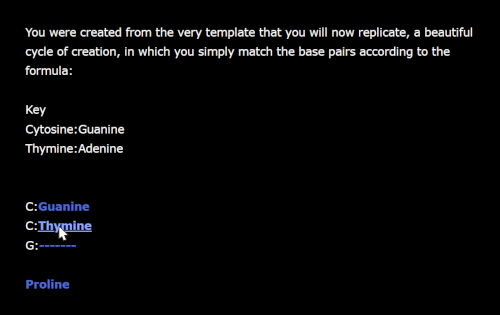
Tenth Plague
Tenth Plague deserves some sort of award for the game I tried most often to quit or lose intentionally this competition[...] Overall, an interesting concept cleanly executed.
-Emily Short
This is a game with a definite point to make, and it's well done, with a commentary mode that's worth unlocking.
-Matt Weiner
[T]his is a horror story, with you as the monster. This isn't a devout game, but neither is it mockingly irreverent. It's a work that dares to take scripture at its word without making excuses for it. It's pretty short, but[...] thorough in its implementation."
-Carl Muckenhoupt
This is terrible! This is a terrible game! I am terrible for playing it!
-Jenni Polodna
There’s an interesting story behind this game: originally, I had intended to create a puzzle game centered around making a gender-affirming outfit using material found around the player’s apartment. It was intended to have a high number of mix-and-match options with different ways to use tools, all while being an exploration of that character’s feelings.
However, my tracking metrics indicated that this sandbox-game-type goal was not hitting expected milestones. Worse, the logic systems handling repurposing items and wearing items were noticeably impacting performance, meaning that even if I did hit my September deadline, I’d only be creating a sluggish, non-responsive game (inexcusable for a text adventure). So, I pivoted to a smaller, focused experience that I knew I could deliver within the timeframe.
I focused on an uncomfortable and emotionally difficult experience: being an agent responsible for senseless and unstoppable death. I made an experience where my criticism is never stated, where no actions are editorialized, but where the impact is strongly felt by players.
While it might be strange to call this an educational game, it being such a short game allowed me to add a commentary mode. In addition to providing historical or religious context, this replay mode also allowed players to gradually process and emerge from an emotionally difficult experience.
A manger
The distressed call from the cow has roused the merchant. You can hear him drunkenly sending his son out to investigate the noise from the manger.
>hide
Subtlety is wise, but unnecessary.
You can hear footsteps.
>wait
You momentarily pause, and shift your consciousness to another area of your cloud body, where a brave (but third-born) man is attempting to attack you.
The merchant’s son enters the manger. It takes him a moment to register what is going on with his livestock, but once he does, he gurgles in fear, attempting to cry out.
>kill firstborn
Knowing that players would want to disagree or rebel, I even made sure to accommodate those as non-options, imparting a bleak sense of hopelessness.
Outside the slave’s hut
You experience physical awareness as you are shoved into Earthly existence: a cloud of death and destruction surrounding the Egyptian city. Parts of you in other areas of the town have already begun the task of cleansing. The southernmost area of your consciousness floats closer to its first victim: the slave boy.
The target is inside and to the north the city continues. A path out of town leads to the south.
>go south
You are already at the southernmost edge of town; going any other direction will be seen as desertion, are you sure you want to abandon your mission?
>yes
For reasons that only you know, you abandon your mission. Angered at the disobedience, your area of consciousness is snuffed out of existence by your creator. Billows of cloud on either side of you seep in to fill the gap you’ve left. The cleansing continues without you.
For such a short and difficult game, it placed a very respectable 12th out of 38th place.

